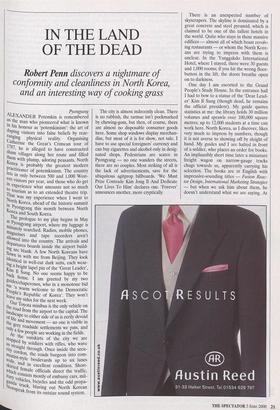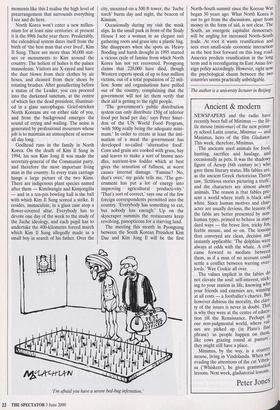IN THE LAND OF THE DEAD
Robert Penn discovers a nightmare of
conformity and cleanliness in North Korea, and an interesting way of cooking grass
Pyongyang ALEXANDER Potemkin is remembered as the man who pioneered what is known in his honour as `potemkinism': the art of duping visitors into false beliefs by rear- ranging physical reality. Organising Catherine the Great's Crimean tour of 1787, he is alleged to have constructed sham villages along her route and filled them with plump, adoring peasants. North Korea is probably the greatest modern practitioner of potemkinism. The country lets in only between 500 and 1,000 West- ern visitors per year, and those who do get in experience what amounts not so much to tourism as to an extended theatre trip. That was my experience when I went to North Korea, ahead of the historic summit Pyongyang this month between North Korea and South Korea. The prologue to my play begins in May at Pyongyang airport, where my luggage is Minutely searched. Radios, mobile phones, magazines and tape recorders aren't allowed into the country. The arrivals and departures boards inside the airport build- ing are blank. A few North Koreans have flown in with me from Beijing. They look "identical in well-cut dark suits, each wear- ba bright lapel pin of the 'Great Leader', m Il Sung. No one seems happy to be uack home. I am greeted by my two guides/chaperones, who in a monotone bid 'a warm welcome to the Democratic leave eople's Republic of Korea'. They won't my sides for the next week. , Our Toyota minibus is the only vehicle on ;Ile road from the airport to the capital. The rdscape to either side of us is eerily devoid th life and movement — no one is visible in owe grey roadside settlements we pass, and AY a few people are working in the fields. s,•_'At the outskirts of the city we are :suPped by soldiers with rifles, who wave straight through. Once inside the secu- Icordon, the roads burgeon into corn- wui..nist-style boulevards up to six lanes „late, and in excellent condition. Short- which'41 ted female officials direct the traffic, consists mostly of embassy cars, mil- grY vehicles bicycles and the odd propa- ganda ' New l blaring out North Korean "'speak from its outsize sound system. The city is almost indecently clean. There is no rubbish, the tarmac isn't pockmarked by chewing-gum, but then, of course, there are almost no disposable consumer goods here. Some shop windows display merchan- dise, but most of it is for show, not sale. I have to use special foreigners' currency and can buy cigarettes and alcohol only in desig- nated shops. Pedestrians are scarce in Pyongyang — no one wanders the streets, there are no couples. Most striking of all is the lack of advertisements, save for the ubiquitous agitprop billboards. 'We Must Prize Comrade Kim Jong II And Dedicate Our Lives To Him' declares one. `Forever' announces another, more cryptically. There is an unexpected number of skyscrapers. The skyline is dominated by a great concrete and steel pyramid, which is claimed to be one of the tallest hotels in the world. Quite who stays in these massive edifices — almost all of which boast revolv- ing restaurants — or whom the North Kore- ans are trying to impress with them is unclear. In the Yanggakdo International Hotel, where I stayed, there were 30 guests and 1,000 rooms; if you hit the wrong floor- button in the lift, the doors breathe open on to darkness.
One day I am escorted to the Grand People's Study House. In the entrance hall I had to bow to a statue of the 'Dear Lead- er' Kim Il Sung (though dead, he remains the official president). My guide quotes statistics at me: the library holds 30 million volumes and sprawls over 100,000 square metres; up to 12,000 students at a time can work here. North Korea, as I discover, likes very much to impress by numbers, though it is not averse to showing off by sleight of hand. My guides and I are halted in front of a soldier, who places an order for books. An implausibly short time later a miniature freight wagon on narrow-gauge tracks chugs towards us, apparently carrying his selection. The books are in English with impressive-sounding titles — Fusion Reac- tor Design, International Marketing Strategies — but when we ask him about them, he doesn't understand what we are saying. At moments like this I realise the high level of prearrangement that surrounds everything I see and do here.
North Korea won't enter a new millen- nium for at least nine centuries: at present it is the 89th Juche year there. Predictably, the calendrical system dates itself from the birth of 'the best man that ever lived', Kim II Sung. There are more than 30,000 stat- ues or monuments to Kim around the country. The holiest of holies is the palace mausoleum. Visitors are X-rayed and have the dust blown from their clothes by air hoses, and cleaned from their shoes by rotating brushes. After genuflecting before a statue of the Leader, you can proceed into the darkened sanctum, at the centre of which lies the dead president, illuminat- ed in a glass sarcophagus. Grief-stricken North Koreans are on either side of you, and from the background emerges the sound of crying and wailing. The noise is generated by professional mourners whose job is to maintain an atmosphere of sorrow all day long.
Godhead runs in the family in North Korea. On the death of Kim II Sung in 1994, his son Kim Jong Il was made the secretary-general of the Communist party, and therefore the most important living man in the country. In every train carriage hangs a large picture of the two Kilns. There are indigenous plant species named after them — Kimilsungia and Kimjongilia — and in a ten-pin bowling hall is the ball with which Kim II Sung scored a strike. It resides, immaculate, in a glass case atop a flower-covered altar. Everybody has to devote one day of the week to the study of the Juche ideology, and each pupil has to undertake the 400-kilometre forced march which Kim Il Sung allegedly made as a small boy in search of his father. Over the city, mounted on a 500 ft tower, the `Juche torch' bums day and night, the beacon of Kimism.
Occasionally during my visit the mask slips. In the small park in front of the Study House I see a woman in an elegant suit gathering roots and grass into a plastic bag. She disappears when she spots us. Heavy flooding and harsh drought in 1995 started a vicious cycle of famine from which North Korea has not yet recovered. Pyongyang claims that 220,000 have died, though Western experts speak of up to four million victims, out of a total population of 22 mil- lion. Some aid organisations have pulled out of the country, complaining that the government will not let them verify that their aid is getting to the right people.
`The government's public distribution system can only distribute 150g of inferior food per head per day,' says Peter Smer- don of the UN World Food Program, `with 500g really being the adequate mini- mum.' In order to create at least the inti- mation of a meal the government has developed so-called 'alternative food'. Corn and grain are cooked with grass, hay and leaves to make a sort of brown noo- dles, nutrient-less fodder which at best gives the sensation of fullness, at worst causes internal damage. 'Famine? No, that's over,' my guide tells me. 'The gov- ernment has put a lot of energy into improving agricultural producti-vity.' `That's sort of correct,' says one of the few foreign correspondents permitted into the country. 'Everybody has something to eat, but nobody has enough.' Up on the skyscraper summits the restaurants keep revolving, panopticons for a starving land.
The meeting this month in Pyongyang between the South Korean President Kim Dae and Kim Jong II will be the first 'I'm afraid you have a severe bed-bug infestation.' North–South summit since the Korean War began 50 years ago. What North Korea is out to get from the discussions, apart from money in the form of aid, is not clear. The South, an energetic capitalist democracy, will be angling for increased North–South trade. At root it wants reunification and sees even small-scale economic interaction as the best foot forward on this long road. America predicts reunification in the long term and is reconfiguring its East Asian for- eign policy accordingly. However, right now the psychological chasm between the two countries seems practically unbridgable.
The author is a university lecturer in Beijing.






































































 Previous page
Previous page